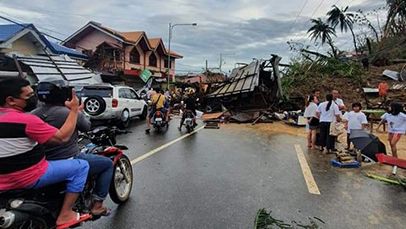The International Federation of Red Cross is raising P1.08 billion (or 20 million Swiss francs) for some 1.8 million Filipinos badly- affected by typhoon Odette (international name Rai) in the Visayas and Mindanao to help restore their lives and properties and provide immediate relief. This after it joined the UN agencies in assessing last weekend the extent of damage to lives and properties of the storm.
GENEVA-based International Federation of Red Cross has launched an emergency appeal for 20 million Swiss francs (P1.08 billion) to fund urgent relief and longer- term recovery efforts for 1.8 million Filipinos affected by typhoon Odette (international name Rai).
This, after an assessment done over the weekend by the UN Office for the Coordination of Humanitarian Affairs (OCGA), a UN agency, joined by the International Red Cross and Red Crescent in the Visayas and Mindanao to assess help for Odette victims.
The humanitarian assessment team sent reports and images that are “heartbreaking,” said Gustavo Gonzalez, UN resident coordinator and humanitarian coordinator in the Philippines.
“Our deepest sympathies go out to those who lost so much, including loved ones”.
“On behalf of the UN and the Humanitarian Country Team, our message to the people of the Philippines is one of solidarity and support.”
“People affected by typhoon Rai need urgent help. We call on all to show solidarity to the Philippines in this hour of need,” Jagan Chapagain, the secretary-general of the IFRC, wrote on Twitter.
Gonzalez said UN agencies, NGOs and private sector partners in the Philippines are now coordinating to meet the “immediate needs in shelter, health, food, protection, and other life-saving responses.”
The UN Office for the Coordination of Humanitarian Affairs (OCHA) is also talking with the Philippine government to “ensure we provide timely support and are fully mobilized in addressing critical gaps and the needs of the most vulnerable.”
The OCHA teams came from Siargao Island where Typhoon Odette made its first landfall on December 16 and posted videos and photos of destruction in the surfing capital of the Philippines.
Gonzalez said one of the priority needs include food, clean water, temporary shelter, fuel, hygiene kits, medical supplies and protection services.
A team from the International Organization for Migration also went to Maasin City in Southern Leyte.
Kristin Dady, IOM Chief of Mission, reported that 90 percent of houses in Maasin were severely damaged, and that urgent needs are food, shelter, electricity, and hygiene kits.
IOM is teaming up with US Agency for International Development, World Food Program and the Foreign Ministry of Germany.
The European Humanitarian Aid has also sent a humanitarian expert to Bohol in Central Visayas.
National Disaster Risk Reduction and Management Council (NDRRMC) Assistant Secretary Casiano Monilla said the UN has sent a letter offering technical expertise and other help that they can offer from their available resources in the Philippines. The NDRRMC has not yet responded to the letter.
In a briefing, Monilla said, the Philippine government has not officially sought the help of foreign governments.
Gonzalez, meanwhile, commended the first responders led by the Armed Forces, Red Cross, and those involved in evacuation, search and rescue despite the “very difficult circumstances and logistics.”
Gonzalez, said that aid assessment teams had reached communities in need of emergency assistance at the weekend, for the first time.
They “were able to access areas and communities hit hardest” by Rai’s 195-kilometre-an-hour (121 miles per hour) sustained winds, with gusts of up to 270kph (168 mph) in central island provinces, Gonzalez said.
His role is to coordinate the response by UN agencies in the Philippines, along with NGOs and private sector partners in the country, which are working with the Government “to meet immediate needs in shelter, health, food, protection” and other life-saving actions.
According to reports, around 1.8 million people have been affected by the catastrophe and at least 208 people are confirmed dead, since the storm made landfall last Thursday.
Landslides and flooding
It is feared that this number will grow, once officials manage to confirm how many victims have perished in reported landslides and extensive flooding.
With some 300,000 people reportedly evacuated as the super typhoon pummeled central regions, immediate and priority needs include food, clean water, shelter, fuel, hygiene kits, medicines and protection services, the report on UN official website said.
Haiyan memories
In November 2013, Typhoon Haiyan hit many of the central provinces that were flattened last week, claiming more than 6,300 lives.
Every year, the Philippines sees an average of 25 typhoons, in addition to regular earthquakes, tidal flooding and alerts from 21 active volcanoes, which are the result of its position on the Pacific Ring Of Fire, so named because of the horseshoe-shaped active tectonic belt that fringes the Pacific basin.
Tags: #IFRCandRedCrescent, #UNOCHA, ##Odettevictims, #VisMin, #typhoon
